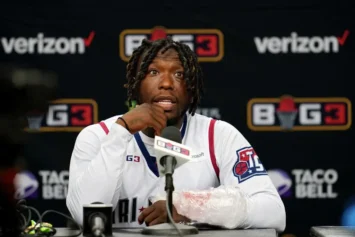
Prodigy counted Hot 97 Summer Jam among his last concerts before his death. (Dave Kotinsky/Getty Images)
“When you get to be a person of my age, you know your triggers,” Raeshal Solomon of Nashville stated when talking about how she lives with sickle cell anemia. Solomon, 36, was diagnosed with the disease as an infant. “You know what you can be around and what you can’t, what you can do and what you can’t. For example, if I am in a high-stress situation — physically or mentally — I know I can get sick. I can have a crisis simply being around secondhand smoke. Sickle cell is all about keeping your environment as pure and clean as possible, including emotional stress. It’s a lot to deal with if you have the disease and it is a lot to deal with if you are a caregiver.”
The death of Mobb Deep’s Prodigy at the age of 42 brought to the spotlight what it means to live with sickle cell. For hundreds of thousands of men, women and children, this disease turns their bodies into war zones, with race, income disparity and education all being obstacles that have slowed or delayed the implementation of a cure. “A sickle cell attack would creep up slowly in my ankles, legs, arms, back, stomach and chest. Sometimes, my lips and tongue turned numb and I knew I was going into a crisis,” Prodigy wrote. “I was a very serious child who never got to enjoy life to the fullest like a normal, healthy kid.”
For one in 100 Americans, their blood — the very elixir of their lives — is poisonous. Sickle cell disease — an often-misunderstood and life-threatening set of diseases caused by a hereditary mutation of the oxygen-carrying protein hemoglobin S — can cause debilitating blood vessel clots, leading to excruciating pain, tissue necrosis, anemia, swelling in the hands and feet, bacterial infection and potentially stroke or death.
The disease hits African-Americans the hardest. Approximately 1 in every 14 Black people has the disease or is a carrier of the trait, compared to 1 in 500 whites.
Perhaps because of this disparity in occurrence rates, research into sickle cell disease has failed to receive the priority that other diseases have. On July 7th, the Food and Drug Administration approved the first new sickle cell drug in more than 20 years. The drug, Endari, is being hailed as a potential breakthrough in sickle-cell pain management for patients 5 years old and older.
“I am hoping we are finally seeing channels opening, and that this will be the first of many new drugs to hit the market [for sickle-cell disease],” Dr. Alexis A. Thompson, head of the Hematology Section and director of the Comprehensive Thalassemia Program at the Ann and Robert H. Lurie Children’s Hospital of Chicago, said to NBC News.
Endari’s development suggests that we are turning a corner in prioritizing sickle cell development. This, however, begs two important questions: Why was sickle cell research deprioritized in the first place? What can be done to make sickle cell less of a health epidemic for the Black community?
Sickle Cell
Sickle cell is a genetic malfunctioning of the oxygen transportation system. Oxygen is carried from the lungs to the cells by means of red blood cells via hemoglobin, which temporarily bonds to oxygen molecules. Sickle cell patients carry a variant of hemoglobin, hemoglobin S. This variant does not easily bind with oxygen. Worse, it affects the red blood cells’ geometry. As the abnormal hemoglobin forms rigid rods in the blood cell, it changes the blood cell from a flexible disk to a rigid crescent sickle shape that does not allow the blood cell to sustain its travel in the vessel walls. Sickle-cell red blood cells tend to get entangled with each other when they bump, causing vessel blockages.
The sudden lack of oxygen to the tissue from these blockages creates sudden, intense moments of pain known as crises. These happen without warning and usually require hospitalization for treatment. The lack of oxygen also causes tissue degradation or necrosis, causing chronic pain for adolescents and adults, as well as organ damage.
Due to the lack of flexibility, sickle cell red blood cells tend to hemolyze or burst apart. The effect of this is that a sickle cell red blood cell typically has a lifespan of 10 to 20 days, compared to the 90 to 120 days of a regular blood cell. This causes sickle cell patients to have a lower red blood cell count than normal. This state, known as anemia, results in diminished energy for the patient.
For those afflicted with sickle cell, the disease vastly influences all aspect of life. Typically, the average lifespan of a sickle cell patient in the United States is 40 years, compared to 72 years for a healthy American. Newborns are screened for sickle cell, with afflicted infants receiving immediate treatment, typically involving a bone marrow transplant. This treatment is effective but is dependent on access.
The Burden of Ignorance
Sickle cell in adults can typically be managed with a drug known as hydroxycarbamide, an orally administered drug that increases the production of fetal hemoglobin, a form of hemoglobin that can bind with oxygen more readily than adult hemoglobin, while suppressing DNA formation of sickle cell red blood cells. The drug itself is relatively inexpensive, however, cost is not the only factor.
“Sickle cell disease is not a commonly-talked-about disease in the USA as far as its danger of causing death, because the majority of the USA population is screened at birth for the disease and treated appropriately if they have it,” Dr. said Erik Serrao, manager of business development at Silver Lake Research, the developer of a rapid screening test for sickle cell. “However, if you go to Uganda, for example, sickle cell disease is one of, if not the largest killer of children under the age of 5.”
Therefore, in low-resource countries, sickle cell disease is quite well-known and talked about. But just because it is talked about doesn’t mean it is under control,” he continued. “The poor in Uganda and the poor in the USA alike suffer from lack of access to proper health care, which includes screening at birth, screening at adulthood and access to hydroxyurea, this new drug Endari, and other drugs that can be prescribed.”
The disease proliferates, however, due to a lack of education and understanding. This lack of understanding extends not only to those afflicted by the disease or the carrier trait but also to those tasked with caring for them.
Life with Poisonous Blood
“When I having a crisis, I would number the crisis on a pain scale from 0 to 10. When I am at a full-blown crisis, where I have to go to the emergency room, that is a 10-out-of-10 pain,” Tosin Ola, a sickle cell patient, said. A registered nurse, Ola created the blog “Sickle Cell Warriors” as a way to reach out to others afflicted with the disease. The blog has since grown into an active advocacy and support network.
“Usually, I try to manage my crises at home, because I realize that going to the hospital all the time was quite stressful and made my pain worse,” she said. “You have to deal with the stigmas and the misconceptions and the poor treatment in the emergency room. All of that is frustrating.”
Ola pointed out that while sickle cell care in this nation is excellent for newborns and children under 5, it is desperately lacking for adolescents and adults. Because infant screening makes the most lethal versions of the disease the exclusive domain of poor Blacks and Latinx or recent immigrants, many doctors — particularly those who work outside of Black population centers — are unfamiliar with adult sickle cell.
“Sickle cell disease can be, and frequently is, mistaken for other health issues,” Serrao noted. “The reason is that the symptoms are many times very vague, especially if the individual does not know that he or she has sickle cell disease.”
It is typical for emergency rooms, after finding nothing on their tests, to write off sickle cell pain as psychosomatic or as an attempt to falsely obtain prescription pain medication. These misdiagnoses can be frustrating and, at times, deadly. Many of those affected by the most serious forms of sickle cell have insufficient health insurance to pay for the emergency room visits and medications. This, coupled with the stress of misdiagnoses and stigmatization, has led many to seek alternative treatments or to “stick it out,” often with disastrous consequences.
The lack of interest in the disease has fueled speculation that because the disease primarily affects African-Americans, it does not receive the attention other genetic defects, such as cystic fibrosis, get. Fewer than a dozen laboratories in the United States are currently committed to sickle cell research and finding benefactors to back studies has proven to be difficult, at best.
“Sickle cell patients have never been at the front of the line,” Dr. David Nathan, a former president of the Dana-Farber Cancer Institute who helped discover hydroxyurea, said to Stat News. “It strikes Italians, Greeks, Blacks. … This work, especially clinical trials, is hugely expensive and the National Institutes of Health and private foundations haven’t prioritized it.”
Finding a Cure
While bone marrow transplants are effective for infants, such treatments incur the cost of having to be permanently on anti-rejection medications. In addition, having blood transfusions — which is typically a prescribed treatment for temporarily increasing the healthy red blood cell count and staving off anemia — creates an environment when an adult bone marrow transfusion would like reject or fail. This leaves few viable options for adult sufferers.
Additionally, there are no viable solutions for pain management. Even if the crises were subsided, the residual tissue damage would create a consistent pain that is difficult to mask or chemically block. For many patients, including Ola, medical marijuana is the only medicine that has been proven to be fully effective for pain relief. The legal access to this, however, is suspect in light of suggestions that the Department of Justice of Attorney General Jeff Sessions may challenge the states on marijuana legalization.
A cure, however, may be in reach. A clinical trial, sponsored by Bluebird Bio, has been conducted following gene therapy on a French boy that has effectively stopped his sickle cell crises. The therapy took the healthy hemoglobin gene and affected the boy’s bone marrow cells, effectively purging the hemoglobin S gene from his system.
The activity from this therapy has given the sickle cell community hope that a cure is within reach and that this generation of patients will be the last to have to endure a sickle cell crisis.


